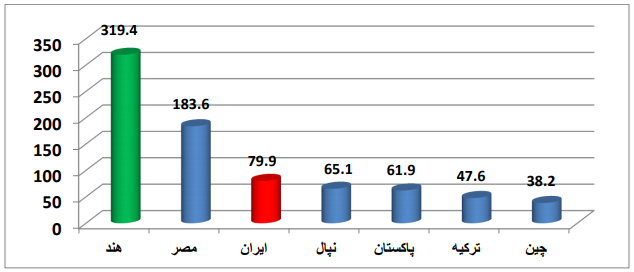
Carpets and other fabric flooring
The art of carpet weaving in Iran dates back to several hundred years BC. Types of carpets can be divided into several ways according to their various characteristics. The most common type of division is based on the size and material of the carpet, which will be briefly described.
Types of carpets in terms of type and size in order from smallest to largest:
1. Padre: Its size is very small and usually 30 x 40 cm.
2. Perspective: The perspective is larger than the paddy and has dimensions of about one square meter. This carpet is used for wall mounting.
3. Back: It is a rural woven back that is generally used for leaning and has dimensions between 50 * 60 or 60 * 80 or 90 * 60 cm.
4. Rumble: It is a rug to pull on the sofa.
5. Saddle: It is a carpet that is used to throw on a horse.
6. Bear: It is a carpet in the approximate size of 90 x 70 cm, which is coarse-textured and less durable.
7. One and a half inches: It is a carpet that is generally woven in the dimensions of 105 x 1 and does not have a fixed width.
8. Two-sided: This carpet is larger than a plow and a half in size and usually has dimensions between 1.20 x 2.
9. Rugs: which are used to perform prayers and its size is equal to the size of two legs.
10. Rug: It is a very common and used carpet whose size varies but is generally woven in the size of 143 x 208 cm.
11. Curtains: These rugs, which usually have a slit for entry and exit, are very finely woven and often silk, woven in two sides.
12. Side, flower (headboard) and between the carpet: All three of these are larger than the rug and are used to fill the empty space of the house. Today, Golki and Miyan carpet are not widely used, but the side is still used to fill the space of corridors.
13. Gabbeh: Gabbeh is a type of carpet that is smaller than a rug and larger than a rug. This carpet has long and fluffy fleeces of goat hair and weft of wool, so it is thick.
14. Carpet: The largest handmade carpet is the carpet, the size of which varies between 2 * 3, 3 * 4, 6 * 4, 7 * 4, 7.20 * 4.80.
Types of carpets in terms of material also include 1- all wool 2- all wool 3- all silk 4- silk floor 5- silk flowers 6- perch.
Carpets are exported under tariff code 5701. According to the statistics, the largest carpet exporters in the world in 2019 are India with 31.7%, Egypt with 18.2% and Iran with 7.9%, respectively.
Carpet industry in Iran
Carpet goods in Iran are under the supervision of the Ministry of Industry, Mines and Trade and its trustee is the "National Carpet Center of Iran". Iran ranks third in the world market with about $ 79 million. Also, the largest importers of this carpet in 2019 are Japan ($ 27787 thousand), Germany ($ 21723 thousand) and Switzerland as the third largest importer of Iranian carpets ($ 5.282 thousand). According to statistics, in the same year, 69 tons of goods worth an average of $ 76.5 per kilo were imported to Switzerland through Iran.
Also, the most expensive carpets of Iran have been sent to Norway and Switzerland this year. It should be noted that this price is higher than the average price of Turkish and Chinese carpets and lower than the average price in Egypt, Nepal and Pakistan.

The value of exports of handmade carpets from Iran and rival countries in 2019
According to another report from the National Carpet Center of Iran, a simple survey will show that the export of Iranian carpets has decreased significantly due to Covid 19 disease and sanctions. The table below shows the amount of Iranian exports in 1398 and 1397.
Iranian carpet market in Switzerland
As it was seen, Switzerland, despite its small population, has a good share in the import of Iranian handmade carpets. Switzerland also has the highest per capita consumption of handmade carpets, and almost all classes and classes of the country are owners or buyers of handmade carpets.
After Hamburg, Zurich is the second most important international trade center for handmade carpets in Europe and one of the most important centers for the re-export of carpets.
There are three types of oriental rugs in Switzerland.
a) Traditional domestic market
b) The market that exists by realtors in open ports, especially Zurich.
c) Antique and antiques market
One of the most popular projects in Switzerland is nomadic and rural projects. The Swiss believe that the large number and order of knots make the carpet look like a machine-made carpet. The next choice of Swiss buyers in carpets, if they do not find Iranian carpets at a good price, is Indian carpets with Iranian designs. Red and light brown and dark brown colors are of interest to this country. The motive for buying carpets of the people of this country is mainly aesthetic, not trade.
Top manufacturers and exporters of Iranian handmade carpets:





